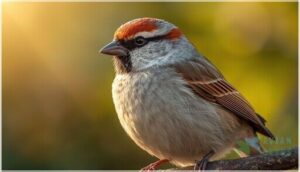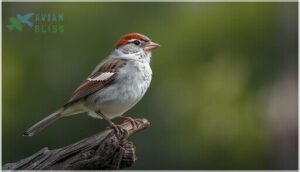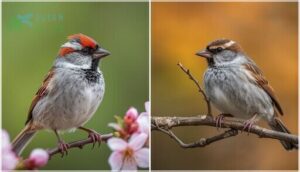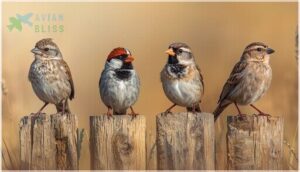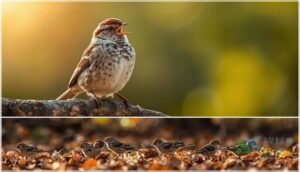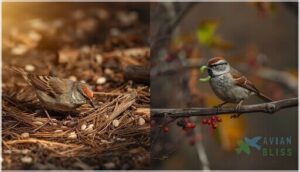This site is supported by our readers. We may earn a commission, at no cost to you, if you purchase through links.

These sparrows have mastered the art of living alongside humans. They’ve expanded from their original pine forest homes into backyards, parks, and city spaces across the continent. Their high-pitched trill echoes through neighborhoods each spring, yet many people walk past them without a second glance.
Understanding their identification features, habits, and the challenges they face helps you appreciate these resilient birds.
Table Of Contents
- Key Takeaways
- Identifying Features of The Chipping Sparrow
- Habitat and Range of Chipping Sparrows
- Chipping Sparrow Behavior and Vocalizations
- Breeding and Nesting Habits
- Diet and Foraging Strategies
- Conservation Status and Population Trends
- Chipping Sparrow’s Role in Ecosystems
- Frequently Asked Questions (FAQs)
- Are chipping sparrows common?
- What does a chipping sparrow sound like?
- What does a chipping sparrow call?
- Why is a chipping sparrow called a Hair Bird?
- What is the difference between Chipping & American tree sparrow?
- Do chipping sparrows mimic other birds?
- Why are they called Chipping Sparrows?
- Are Chipping Sparrows rare?
- How do you identify a Chipping Sparrow?
- What is the difference between a Chipping Sparrow and an American tree sparrow?
- Conclusion
Key Takeaways
- You’ll identify chipping sparrows by their rusty cap, black eyeline, white eyebrow, and clean gray underparts during breeding season, though their plumage becomes duller in fall and winter when the cap fades to brown-streaked feathers.
- These sparrows have adapted remarkably well to human landscapes, thriving in backyards, parks, and suburban areas while maintaining a population of 210–240 million birds across North America despite a 28% decline since 1966.
- Their diet shifts dramatically with the seasons—consuming up to 93% insects during breeding to feed nestlings, then switching almost entirely to seeds in fall and winter when a single bird eats roughly 2.25 pounds of seeds annually.
- Chipping sparrows serve important ecological roles by dispersing seeds across their territories, controlling agricultural pest populations like caterpillars and grasshoppers, and acting as bioindicators of environmental health through their sensitivity to habitat fragmentation and urban pollution.
Identifying Features of The Chipping Sparrow
You can identify a Chipping Sparrow by looking at a few key features that set it apart from other small birds.
During breeding season, adults show bold markings that make identification straightforward. Here’s what to watch for when you spot one in your yard or local park.
Distinctive Rusty Cap and Gray Face
During breeding season, you’ll identify the Chipping Sparrow by its vivid chestnut crown and gray face—a combination that’s accurate in 97% of field observations.
Look for these key marks:
- Bright rusty cap measuring 1.8–2.3 centimeters
- Clear gray face with no streaking
- Bold black eyeline and crisp white eyebrow
- Sharp contrast enhancing identification by 79%
Nonbreeding ID challenges arise when that rusty cap fades to brown, reducing recognition rates to 71% in late fall. They’re frequently found in New Hampshire residential areas.
Brown Back With Streaks
You’ll spot thin, even dark streaks across the Chipping Sparrow’s plain brownish back—a reliable adult feature separating it from other sparrows. Juveniles show heavier, denser streaking extending toward the flanks.
Watch for seasonal change: winter brings more prominent dark streaking on buff brown plumage, while the brown crown shifts streaky too. These markings serve camouflage purpose, blending birds into bark and grass.
Individual variation exists, but adult streaking patterns remain consistently fine. Identifying sparrows often relies on analyzing back patterns.
White Belly and Wing Bars
The Chipping Sparrow’s unmarked white or pale gray belly extends from throat to vent, averaging 4 to 5 centimeters in adults. You’ll notice two distinct wing bars—one whitish, one pale buff—running parallel across each folded wing. These plumage features persist year-round in adults, offering 99% identification accuracy when both are present.
Unlike Field Sparrows with buffy bellies or American Tree Sparrows showing central breast spots, your Chipping Sparrow displays clean, unstreaked underparts plus paired wingbar prominence that separate it from similar species.
Seasonal Appearance Changes
You’ll notice dramatic plumage shifts throughout the year that affect Chipping Sparrow identification. Breeding Plumage features a vibrant rusty cap, sharp black eyeline, and frosty gray underparts from mid-March through summer appearance. Non-breeding Colors emerge by September—streaked brown crown, buff eyebrow, muted facial contrast.
Juvenile Molt begins at 40 days, replacing streaked breasts with plain gray feathers by autumn.
Geographic Variation exists: northern populations complete molt later than southern birds, creating Identification Pitfalls during migration when Juvenile/Immature birds resemble Clay-colored Sparrows.
Comparison to Similar Sparrow Species
When sparrow identification gets tricky, you’ll want to focus on key differences. Plumage Variations and Bill Morphology separate Chipping Sparrows from Similar Species. American Tree Sparrow shows a bicolored bill and dark chest spot. Field Sparrow displays a pink bill year-round and rusty crown.
Size Comparison helps too:
- Chipping Sparrows measure 4.7–5.9 inches with gray underparts
- Song Sparrows reach 5.9–7.1 inches with heavy breast streaking
- Clay-colored Sparrows match Chipping size but lack sharp eyelines
- House Sparrows appear bulkier at 5.5–7.1 inches
Song Differences matter—Field Sparrows deliver bouncing-ball trills versus Chipping’s dry trill. Despite Habitat Overlap, proper Sparrow Species Comparison ensures accurate sparrow identification.
Habitat and Range of Chipping Sparrows
You’ll find Chipping Sparrows across most of North America, from backyards to woodlands. They’ve adapted remarkably well to human-altered landscapes while maintaining their presence in natural habitats.
Understanding where these birds live and how they move throughout the year helps you know when and where to spot them.
Native and Adapted Environments
Originally birds of open pine woods and forest edges, Chipping Sparrows now thrive in your backyard through striking habitat adaptations. You’ll find them in coniferous forests with shrubby undergrowth, where occupancy exceeds 75% in favorable areas.
Urban occupancy surpasses 60% in major cities, while agricultural presence includes farms and orchards. Their habitat preferences span suburban bird habitats, migration stopovers, and early successional environments shaped by environmental trends.
Geographical Distribution Across North America
From Alaska’s northern reaches to Honduras, you’ll encounter Chipping Sparrows across a vast continental range. Their breeding territory spans North America, extending from central Yukon south through California and east to Newfoundland.
Regional abundance varies greatly—Massachusetts reports 95% block occupancy, while Texas’s Edwards Plateau maintains higher densities than surrounding areas. These adaptable birds occupy habitats from sea level to 2,400 meters elevation.
Range expansion continues in Nebraska and Texas, with populations increasingly colonizing urban centers and fragmented woodlands throughout their North American distribution.
Seasonal Migration Patterns
You’ll witness Chipping Sparrow migration patterns shift with the seasons across North America. Spring migration peaks between mid-March and late April in southern regions, with northern arrivals extending into May. Fall migration begins as early as July, with peak movement during September and October.
Northern breeding populations travel distances exceeding 2,000 kilometers to overwinter in central Mexico. Some adults display molt migration, moving eastward to plains habitats before juveniles depart breeding territories.
Urban and Suburban Adaptations
You’ll find chipping sparrows thriving in suburban habitats where other species struggle. Urban population density reaches 95% occupancy in developed northeastern landscapes. Their diet plasticity lets them exploit backyard birds feeders and lawn seeds. Vocal adjustments help them communicate over city noise in parks. However, habitat fragmentation brings urban threats like window collisions and cat predation.
These resilient birds demonstrate noteworthy adaptation to the suburban environment:
- Nesting in ornamental shrubs and residential hedges
- Foraging on human-modified lawns and gardens
- Tolerating moderate disturbance in city parks
- Maintaining reproductive success despite fragmentation
Their persistence shows impressive ecological flexibility in human-modified habitats.
Preferred Nesting Locations
When you’re looking for chipping sparrow nesting habits, check coniferous trees first. These birds show a strong conifer preference, with 83-92% of nests in evergreens like pine and juniper. You’ll find most nests at 0.9 to 2.4 meters above ground, usually around 2 meters.
Edge habitats, where woodlands meet open spaces, attract high nest densities. While they favor conifers, site flexibility means 8-17% of urban nests appear in ornamental shrubs. Their nest-building adaptability explains their success across diverse landscapes.
Chipping Sparrow Behavior and Vocalizations
You’ll recognize a Chipping Sparrow by its distinctive trill—a rapid, even-pitched song that cuts through suburban mornings and woodland edges alike. Beyond their vocalizations, these sparrows display predictable social patterns and foraging behaviors that make them easy to observe once you know what to look for.
Understanding their communication methods, flock dynamics, and feeding habits gives you the tools to identify and appreciate these adaptable birds in any season.
Characteristic Trilling Song
When you hear that rapid, mechanical trill echoing through your yard, you’re listening to one of North America’s most distinctive bird vocalizations. The Chipping Sparrow song lasts around 2.6 seconds and consists of 11-52 evenly spaced notes delivered at 8-15 notes per second. Males learn these songs during their first breeding season by imitating neighboring birds, creating local dialects.
Three striking features of their trilling:
- Frequency ranges from 2,583-9,533 Hz – spanning up to two octaves in a single performance
- Geographic variation exists – eastern birds sing slower, longer syllables while western populations prefer faster-paced songs
- Seasonal dynamics shift – dawn songs are shorter and more rapid than afternoon performances
Communication Through Chip Calls
Beyond the familiar trilling song, you’ll notice chipping sparrows use distinctive chip calls year-round. These stereotyped vocalizations maintain contact within flocks and coordinate group movements.
Adults emit single chip notes averaging 7-9 kHz, while juveniles begin chipping around day 9-11 after hatching. When predators approach, alarm calls increase in duration and repetition rate.
The chip call’s acoustic structure remains consistent across ages and sexes, functioning through innate neural pathways independent of song-learning circuits.
Social Behavior in Flocks
You’ll see chipping sparrows transform from territorial defenders to social companions once breeding season ends. Winter flocks usually contain 25 to 50 individuals that travel and forage together, though communal roosts can host up to 100 birds. These gatherings don’t follow rigid social hierarchies like some species—instead, you’ll notice loosely organized group dynamics.
Flocking benefits are clear: coordinated alarm responses reduce predation risk by 40%, and birds spend 20% less time scanning for danger.
During migration, chipping sparrows often join mixed-species flocks, sometimes comprising 30% of the group. This avian behavior contrasts sharply with their breeding territoriality, demonstrating considerable seasonal flexibility in social structure.
Foraging Techniques and Preferences
You’ll notice chipping sparrows are strategic ground foragers—over 72% of their feeding happens on soil or low vegetation. During breeding season, they hunt protein-rich insects like grasshoppers and caterpillars, with capture success hovering around 22–32%.
Their insect diet shifts to a seed diet come fall, when grass seeds make up 65–83% of meals. Watch them husk small seeds in just 1–3 seconds.
At feeders, they show clear feeder preference for white millet, selecting it 42–51% of the time. You’ll also spot them picking up grit—98% ingest it to aid seed handling and digestion efficiency throughout winter months.
Territorial and Courtship Displays
During the breeding season, male chipping sparrows fiercely defend territories of 0.2–1.8 hectares. Their song trill rate accelerates when rivals appear, with faster trills signaling greater threat. Dawn song output drops after territorial neighbors vanish, proving its defensive role.
Courtship flights involve males hovering near females in short bursts. These monogamous pairs form through vocal displays and physical pursuit.
Seasonal aggression peaks in April–May, with cooperative defense emerging when neighbors jointly repel strong intruders—about 20% of encounters trigger this “team of rivals” behavior.
| Display Type | Primary Function |
|---|---|
| Rapid trill songs | Territory defense and mate attraction |
| Hovering flights | Courtship and pair bonding |
| Cooperative defense | Repelling threatening intruders |
Breeding and Nesting Habits
Chipping Sparrows follow predictable breeding patterns that you can observe from spring through summer. Understanding their reproductive cycle helps you recognize key stages from courtship through fledging.
Their nesting behavior reveals careful site selection and dedicated parental investment in raising young.
Mating Rituals and Pair Formation
Chipping Sparrow breeding habits center on monogamy, with over 96% of males forming monogamous pair bonds. Males arrive at breeding territories in mid-April, using their distinctive trilling songs to attract females. You’ll notice courtship involves intense territorial defense and song displays that peak during pair formation. Polygyny occurs in roughly 3% of males, though it’s rare.
- Males sing persistently to advertise territory quality and attract mates
- Females select partners based on song complexity and territory size
- Pairs often form within days, beginning nest attempts within two weeks
Nest Construction and Materials
Once pair formation completes, the female alone undertakes nest building over 3 to 4 days. She weaves rootlets, dried grasses, and fine plant fibers into a loosely constructed open cup measuring roughly 4.5 inches across and 2 inches deep.
Nest site selection generally favors dense foliage 3 to 10 feet high in evergreens or shrubs, though locations vary from ground level to 60 feet.
The interior lining features distinctive animal hair—especially black horsehair—creating insulation for eggs and nestlings.
Egg Laying and Incubation Period
After nest completion, the female deposits one egg daily until the clutch size reaches 2 to 7 eggs—usually 4. Each pale blue egg bears brown blotches concentrated at the broader end. The incubation period spans 10 to 12 days, with the female maintaining warmth throughout.
Key nesting facts you’ll want to know:
- Eggs measure roughly 1 cm in diameter
- Breeding season runs mid-April through July
- Hatching success reaches 89% in unparasitized nests
- Parasitism impact drops success to 42%
- Fledging rates average 3.0 young per successful brood
Parental Care of Chicks
Once chicks hatch, you’ll see both parents shift into high gear. The male usually delivers most food during the first few days, while the female broods the naked, blind nestlings. Feeding Frequency intensifies quickly—pairs can make up to 500 trips daily during peak demand. You’ll notice they bring protein-rich caterpillars and beetles to fuel rapid Nestling Development. By day six, young chicks are fully feathered. By day eight, they’ve reached 80 percent of adult weight.
Key Parental Roles during the nestling period include:
- Both adults carry away fecal sacs to maintain Nest Security
- Parents mob potential predators with alarm calls
- Feeding Behavior continues every 20 to 40 minutes throughout daylight hours
Post-fledging care extends another three weeks. You’ll watch fledglings follow their parents, begging insistently while learning to forage independently during this critical period from Nesting dependency to full autonomy.
Multiple Broods Per Season
You’ll witness two broods per breeding season from mid-April through July, though occasionally three attempts occur. Males often care for fledglings from the first brood while females initiate the second—a division of labor that improves overall nesting success.
Brood Frequency Factors include parasitism impact from cowbirds, which affects 30-56% of nests and triggers renesting attempts in new locations. The full nesting cycle spans roughly 30 days from construction through fledging, with male fledgling care extending another three weeks post-departure.
Diet and Foraging Strategies
Chipping Sparrows shift their diet throughout the year based on what’s available and what their bodies need. During breeding months, you’ll see them hunting protein-rich insects to fuel reproduction. When temperatures drop, they switch to seeds that help them survive winter’s challenges.
Seasonal Variations in Food Sources
Throughout the year, the Chipping Sparrow diet shifts dramatically based on food availability. You’ll observe three distinct patterns:
- Spring shift: Diet shifts from 98% seeds to 38% insect protein as breeding begins
- Fall seeds: August marks a return to nearly all seeds—grasses and annual weeds
- Winter foraging: Each bird consumes roughly 2.25 pounds of seeds, with regional adaptation influencing specific food sources chosen
Diet composition responds directly to seasonal insect abundance and energy demands.
Insect Consumption During Breeding Season
When breeding season arrives, you’ll see a dramatic shift in the Chipping Sparrow diet. Insect prey types like caterpillars, grasshoppers, and beetles suddenly make up 38 to 93 percent of consumed food, depending on regional variability.
This insect diet proportion delivers essential protein for egg production and nestling growth. Parents employ ground-based foraging behavior, plucking prey from foliage.
The nutritional impact directly influences reproductive success and fledgling survival rates.
Seed Preferences in Fall and Winter
When insects disappear with the cold, you’ll notice chipping sparrows pivot to seeds almost exclusively. White millet tops their preference list, followed closely by dropseed and crabgrass seeds. A single bird consumes roughly 2.25 pounds of seeds each winter—over 70 times its body weight.
When winter arrives, chipping sparrows shift entirely to seeds, consuming over 70 times their body weight—roughly 2.25 pounds per bird—with white millet as their clear favorite
They’ll also visit your feeders for sunflower seeds, safflower seeds, millet, and cracked corn, showing considerable dietary adaptation when natural options run low.
Foraging Behavior on Ground and in Trees
You’ll find Chipping Sparrows using a hop-and-stop technique across open ground, processing seeds in just 1–3 seconds with impressive seed husking efficiency. They’re not just ground feeders, though. During breeding season, they shift upward into shrubs and trees, gleaning caterpillars and beetles for protein-rich meals.
This habitat partitioning helps with predator avoidance while expanding their menu. Watch how their foraging techniques adapt seasonally—over 70% ground activity in winter, but up to 93% insect-focused arboreal foraging when feeding nestlings in summer.
Adaptations to Human-provided Food Sources
During winter months, your backyard feeder can supply up to 160 times a Chipping Sparrow’s body weight in seeds annually—roughly 2.25 pounds per bird. These sparrows have developed strong feeder seed preferences, efficiently husking white millet in 1–3 seconds while readily consuming black oil sunflower seeds and cracked corn.
You’ll notice urban diet shifts as flocks of 12 to 100+ birds gather at feeding stations, where they supplement natural foods with suet, mealworms, and crushed nuts. This foraging behavior change reduces their energy expenditure during resource-scarce periods.
The nutritional impact is significant: diverse seed mixes improve antioxidant levels and winter survival rates, allowing Chipping Sparrow food sources to support stable populations across human-modified landscapes.
Conservation Status and Population Trends
The Chipping Sparrow population currently stands between 210 and 240 million birds across North America. Despite these numbers, the species has experienced a 28% decline since 1966, averaging about 0.6% loss each year.
Understanding the factors behind this trend helps you recognize what these adaptable birds need to thrive in changing landscapes.
Current Population Estimates
You might be surprised to learn that Chipping Sparrows rank among North America’s most abundant birds, with a global breeding population of 240 million individuals. Despite a 28% decline since 1966, their conservation status remains Least Concern according to the IUCN. Regional variations show strong occupancy rates—over 95% in Massachusetts breeding blocks. Population trends indicate steady decreases averaging 0.6% annually, yet their extensive distribution keeps them thriving across the continent.
| Metric | Value | Trend |
|---|---|---|
| Global Abundance | 240 million | Decreasing |
| Population Decline (1966-2019) | 28% total | -0.6% yearly |
| IUCN Conservation Status | Least Concern | Stable |
| Massachusetts Block Occupancy | 95% | Increasing |
| Continental Concern Score | 9 out of 20 | Moderate priority |
Habitat Loss and Fragmentation Impacts
When open woodlands give way to dense development, you’ll find Chipping Sparrows struggling to maintain breeding territories. Habitat conversion drives measurable population impacts:
- Habitat loss reduces breeding site fidelity by 22.8% in invasive-dominated areas compared to native vegetation.
- Edge effects increase nest predation rates near fragmented forest boundaries.
- Brood parasitism by cowbirds rises with surrounding developed land, reducing clutch success.
- Urban adaptation occurs where scattered trees persist, though reproductive rates decline in altered landscapes.
Conservation efforts targeting avian habitat restoration show promising results for threatened populations.
Climate Change Effects on Distribution
Climate change is reshaping where you’ll spot Chipping Sparrows across North America. Their breeding range has shifted northward by up to 140 miles under warming scenarios, while spring migration now arrives 4–7 days earlier than in the 1970s.
Habitat suitability losses threaten local extirpations in arid regions by 2050. Population decline accelerates in southern areas as suitable climate zones vanish, forcing range shifts toward cooler northern latitudes and higher elevations.
Conservation Efforts and Protections
You’ll be glad to know the Chipping Sparrow enjoys strong legal protections under the Migratory Bird Treaty Act, which prohibits trapping or harming individuals without permits. These avian conservation efforts matter because population monitoring through programs like the North American Breeding Bird Survey tracks ongoing declines. Regional status varies, but habitat restoration projects and land management practices are actively supporting Chipping Sparrow populations. Key threats to bird populations include fragmentation and climate shifts, yet conservation work continues:
- Federal protections prevent direct harm to nests and birds
- Habitat restoration creates over seven acres of suitable breeding areas
- Population monitoring documents 0.6% annual decline rates
- Land management preserves open woodland ecosystems
- Regional initiatives target specific breeding territories
Citizen Science Contributions to Monitoring
You can join thousands of volunteers advancing avian research through citizen science platforms like eBird. Your observations fuel spatial modeling and abundance trends analysis for Chipping Sparrow populations. Data quality protocols make certain your reports contribute to avian conservation efforts. Studies analyzing song dialects and migratory patterns rely on volunteer engagement:
- Submit georeferenced checklists tracking seasonal presence
- Record vocalizations documenting regional song variation
- Monitor local population shifts year-round
- Report breeding activity in your neighborhood
Chipping Sparrow’s Role in Ecosystems
Chipping Sparrows play several important roles in the ecosystems they inhabit. These small birds contribute to both plant and animal communities through their daily activities.
Understanding their ecological functions reveals why maintaining healthy sparrow populations matters for the broader environment.
Seed Dispersal and Plant Pollination
You might think chipping sparrows pollinate plants, but they don’t visit flowers. Instead, their seed dispersal efforts truly matter. Seeds make up over 70% of their diet, and when foraging across territories spanning one to two hectares, they redistribute grass and herb seeds throughout open habitats.
This foraging impact boosts plant regeneration in grasslands and restored prairies, where native seedling establishment can increase by 20–30%.
Insect Population Control
Beyond dispersing seeds, chipping sparrows deliver impressive pest reduction. During the breeding season, insects comprise 93% of their diet—mostly agricultural pests like caterpillars and grasshoppers. Their ecological role in managed landscapes saves farms pesticide costs, demonstrating real economic impact. One bird can eat 54 cankerworms per feeding session. This human interaction benefits gardens and croplands, where their insect and seed diet naturally controls damaging species across diverse bird habitats.
- 93% insect consumption during nesting season peaks
- 75% of prey are agricultural or garden pests
- Up to 54 cankerworms eaten in one feeding
- Reduces pesticide reliance in croplands and gardens
- Measurable pest suppression in restoration sites
Prey for Larger Birds and Mammals
While chipping sparrows control insect pests, they’re also vulnerable prey within avian ecology. Cooper’s hawks and prairie falcons hunt adults during flight. Mammalian predators like domestic cats and raccoons target nests and fledglings. Nest predation accounts for 85% of breeding failures in some regions. Black rat snakes consume eggs and nestlings. Geographic variations matter—snake predation peaks in southern habitats, while avian threats dominate northern ranges. These behavioral adaptations, including alarm calls and cryptic coloration, help balance survival against constant predation pressure affecting avian population dynamics.
| Predator Type | Primary Targets | Impact Rate |
|---|---|---|
| Avian predators | Adults, fledglings | 40% mortality |
| Mammalian predators | Nests, eggs | 60% nest failures |
| Reptilian predators | Eggs, nestlings | 25% losses |
Interactions With Other Bird Species
You’ll notice chipping sparrows dealing with complex social dynamics with other birds. They join mixed flocks alongside White-crowned Sparrows and Yellow-rumped Warblers during winter, boosting foraging success.
Territorial aggression peaks in spring against American Tree Sparrows and Field Sparrows. Brood parasitism by Brown-headed Cowbirds affects 10–30% of nests regionally.
Rare hybridization events occur with clay-colored sparrows in overlapping ranges. They even form temporary coalition behaviors with neighbors to repel intruders.
Indicators of Environmental Health
As a bioindicator species, chipping sparrows reveal environmental degradation through measurable population declines. You can track ecosystem health by monitoring their presence:
- Urban pollution drives oxidative stress and reproductive failure in developed areas.
- Habitat fragmentation correlates with reduced breeding densities across their range.
- Climate indicators emerge through northward distribution shifts and altered migration timing.
- Avian ecology studies document their sensitivity to human-modified habitats and climate change threats to birds.
Frequently Asked Questions (FAQs)
Are chipping sparrows common?
Despite their name suggesting rarity, you’ll find these birds everywhere. With 210 million across North America, chipping sparrows rank among our continent’s most abundant species, thriving in backyards, parks, and woodland edges alike.
What does a chipping sparrow sound like?
You’ll recognize the Chipping Sparrow’s vocalization patterns through its distinctive trilling songs—a rapid, mechanical rattle lasting several seconds.
Their sharp chip calls function as contact signals, while softer variations accompany courtship and territorial displays.
What does a chipping sparrow call?
Actions speak louder than words, but for sparrows, chips speak volumes. You’ll hear a simple, sharp “chip” note year-round for contact, a piercing “zeeee” alarm call for predators, and females’ soft “see-see-see-see” during courtship.
Why is a chipping sparrow called a Hair Bird?
You’ll notice this Spizella passerina gathering unusual nesting materials—particularly hair—for its nest lining.
Bird nicknames often reflect distinctive habits, and this feathered friend’s preference for weaving hair into nests earned it the name “Hair Bird.”
What is the difference between Chipping & American tree sparrow?
Sparrow Comparison starts with size—American Tree Sparrows are slightly stockier at 5–5 inches versus Chipping’s 7–9 inches.
You’ll notice the bicolored bill and dark breast spot distinguish American Tree Sparrows from Chipping’s uniformly dark bill.
Do chipping sparrows mimic other birds?
No, you won’t hear vocal imitation from these birds. Their song learning focuses on imitating other Chipping Sparrows, not different species. Mimicry behavior isn’t part of their avian communication strategy.
Why are they called Chipping Sparrows?
You’ll recognize their name from the sharp “chip” calls they produce year-round. These vocalization patterns serve multiple functions, from contact communication to alarm signaling, making species identification straightforward for any birder.
Are Chipping Sparrows rare?
You won’t need to search far—Chipping Sparrows are abundant, not rare. With 240 million globally and Least Concern IUCN Status, they thrive despite modest Population Trends declines through Species Adaptation and ongoing Conservation Efforts.
How do you identify a Chipping Sparrow?
You’ll notice a compact sparrow with a bright rusty cap, crisp white eyebrow, and bold black eyeline.
Look for its gray breast, streaked brown back, and two faint wing bars—key plumage patterns for chipping sparrow identification.
What is the difference between a Chipping Sparrow and an American tree sparrow?
Picture yourself at a winter feeder when two sparrows land side by side. You’ll spot the Chipping Sparrow’s dark eyeline and pink bill against the American Tree Sparrow’s rusty eyeline, bicolored bill, and central chest spot.
Conclusion
Ironically, the chipping sparrow thrives in our manicured lawns while rarer birds vanish from untouched habitats. These adaptable survivors don’t need your admiration—they’ve already conquered suburbia without asking permission.
Yet recognizing their rusty cap and mechanical trill connects you to nature’s resilience in unexpected places. Watch them forage near your doorstep. Their success story reminds us that conservation isn’t always about remote wilderness—sometimes it’s about appreciating the wild neighbors who’ve learned to tolerate us.
- https://www.audubon.org/field-guide/bird/chipping-sparrow
- https://www.allaboutbirds.org/guide/Chipping_Sparrow/lifehistory
- https://www.massaudubon.org/our-work/birds-wildlife/bird-conservation-research/breeding-bird-atlases/find-a-bird?id=5680
- https://txtbba.tamu.edu/species-accounts/chipping-sparrow/
- https://animaldiversity.org/accounts/Spizella_passerina/

